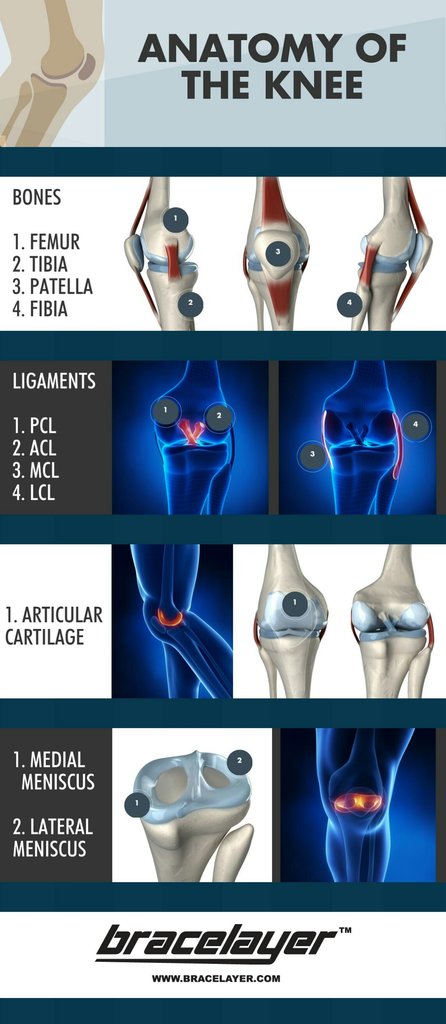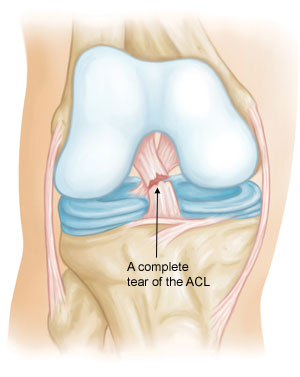Anterior Cruciate Ligament (ACL) Injuries——Functional ACL Knee Brace
Anatomy of the Human Knee - Infographic
The knee is one of the largest and most important joints in the human body as it connects the upper (femur) and lower (tibia) leg. The muscles that move the knee are connected by tendons to the knee bones. In addition to these bones, the joint is comprised of ligaments, which connect the knee bones and provide stability, as well as menisci and cartilage which function as shock absorbers and allow the joint to move with less friction.
The main ligaments connecting the bones and providing stabilty to the knee are:
The Anterior Crutiate Ligament - The ACL lies deep within the knee joint and provide significant stability to the joint.
The Posterior Crutiate Ligament - The PCL connects the back of the tibia to the femur and stops the shinbone or tibia from moving backwards in relation to the knee.
The Medial & Lateral Crutiate Ligaments - MCL & LCL, stabilize the side to side movement of the femur in relation to the knee.
Check out our infographic below for a visual breakdown of the anatomy of the human knee:

Anterior Cruciate Ligament (ACL) Injuries
One of the most common knee injuries is an anterior cruciate ligament sprain or tear.
Athletes who participate in high demand sports like soccer, football, and basketball are more likely to injure their anterior cruciate ligaments.
If you have injured your anterior cruciate ligament, you may require surgery to regain full function of your knee. This will depend on several factors, such as the severity of your injury and your activity level.
Anatomy
Three bones meet to form your knee joint: your thighbone (femur), shinbone (tibia), and kneecap (patella). Your kneecap sits in front of the joint to provide some protection.
Bones are connected to other bones by ligaments. There are four primary ligaments in your knee. They act like strong ropes to hold the bones together and keep your knee stable.

Collateral Ligaments
These are found on the sides of your knee. The medial collateral ligament is on the inside and the lateral collateral ligament is on the outside. They control the sideways motion of your knee and brace it against unusual movement.
Cruciate Ligaments
These are found inside your knee joint. They cross each other to form an "X" with the anterior cruciate ligament in front and the posterior cruciate ligament in back. The cruciate ligaments control the back and forth motion of your knee.
The anterior cruciate ligament runs diagonally in the middle of the knee. It prevents the tibia from sliding out in front of the femur, as well as provides rotational stability to the knee.
Description
About half of all injuries to the anterior cruciate ligament occur along with damage to other structures in the knee, such as articular cartilage, meniscus, or other ligaments.
Injured ligaments are considered "sprains" and are graded on a severity scale.
Grade 1 Sprains. The ligament is mildly damaged in a Grade 1 Sprain. It has been slightly stretched, but is still able to help keep the knee joint stable.
Grade 2 Sprains. A Grade 2 Sprain stretches the ligament to the point where it becomes loose. This is often referred to as a partial tear of the ligament.
Grade 3 Sprains. This type of sprain is most commonly referred to as a complete tear of the ligament. The ligament has been split into two pieces, and the knee joint is unstable.
Partial tears of the anterior cruciate ligament are rare; most ACL injuries are complete or near complete tears.

Cause
The anterior cruciate ligament can be injured in several ways:
Changing direction rapidly
Stopping suddenly
Slowing down while running
Landing from a jump incorrectly
Direct contact or collision, such as a football tackle
Several studies have shown that female athletes have a higher incidence of ACL injury than male athletes in certain sports. It has been proposed that this is due to differences in physical conditioning, muscular strength, and neuromuscular control. Other suggested causes include differences in pelvis and lower extremity (leg) alignment, increased looseness in ligaments, and the effects of estrogen on ligament properties.
Symptoms
When you injure your anterior cruciate ligament, you might hear a "popping" noise and you may feel your knee give out from under you. Other typical symptoms include:
Pain with swelling. Within 24 hours, your knee will swell. If ignored, the swelling and pain may resolve on its own. However, if you attempt to return to sports, your knee will probably be unstable and you risk causing further damage to the cushioning cartilage (meniscus) of your knee.
Loss of full range of motion
Tenderness along the joint line
Discomfort while walking
Do you wear a custom knee brace?
Do you wear a custom knee brace? If the answer is ‘YES’, then Orthomen Functional ACL Knee Brace are built for you.
At 15 years of age I suffered a complete tear of my left ACL during a basketball game. I tried not to let my injury slow me down but over the course of the next twenty years I had a number of knee operations including a few arthroscopic surgeries to remove damaged meniscus and cartilage, 3 unsuccessful ACL reconstructions using patellar tendon and then left and right hamstring tendons and most recently a high tibial osteotomy where my tibia plateau was cut in half and a wedge shaped disc from my pelvic bone was inserted into the tibia plateau to realign the knee.
Orthomen Functional ACL Knee Brace Designed to provide stability and support following injury or reconstruction of the ACL/PCL/LCL, The Functional ACL Knee Brace features a lightweight sturdy frame lined with durable soft goods for the combination of optimum support and comfort. This is the perfect brace for those active patients needing additional support during recovery.
Indications:
Knee instability due to anterior and/or posterior cruciate ligament ( ACL/PCL/LCL injuries )
To restrict the range of motion after reconstructive surgery
Recommended for low to medium impact sports
Features:
ROM hinges with plug-in flex/ext stops
Extension limitation at: 0°, 10°, 20°,30° , Flexion limitation at: 0°, 30°, 45°, 60°, 90° , Immobilization limitation at: 0°, 30°
Hypoallergenic silicone-grip strap pads for anti-migration
Concentric condyle pads correspond to bilateral femoral condyles.
Numbered straps provide desirable counter force and adjust optimal size.
Do you wear a custom knee brace? Please share your knee story in our comments section!
- Choosing a selection results in a full page refresh.


5 comments
Sahil soni
Hello guys I am from India and I tear me ligament but after 30 day plaster and than wear supporter for 39 day and than I feel better
Golfaholic
This product was very good value and has proved exhalent knee support just wish I had bought it sooner
Armstrong
I have a meniscus problem and this knee brace works great, I run 6 to 9 miles three times a week and thought I would have to give up running, this brace has given me new hope. I now wear it every day, no discomfort what so ever.
Mark PP
I highly recommend this produce if you need a brace for ACL tear that will not deteriorate within a matter of days, stays on securely, provides stability.
Jordan Whitaker
My doctor never gave me a knee brace for my knee. He said he doesn’t want me to rely on it as a crutch with my cheeeading activities. I’m a little concerned if this is a good or bad thing to not have a brace for my knee.